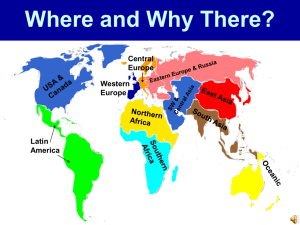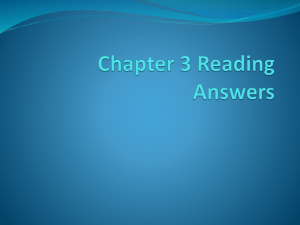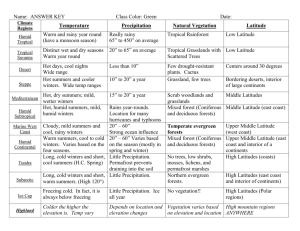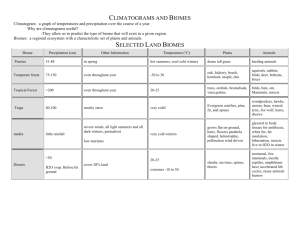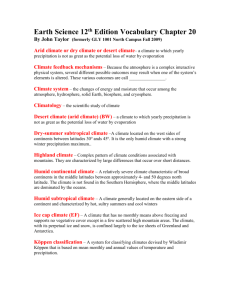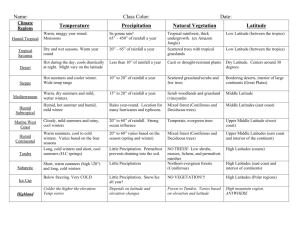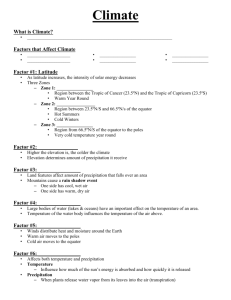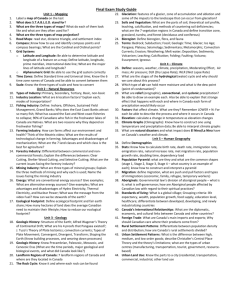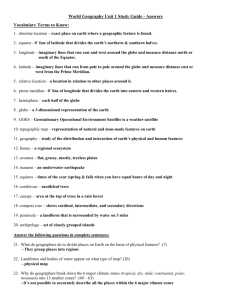5 Themes of Geography: Location, Place, Regions
advertisement
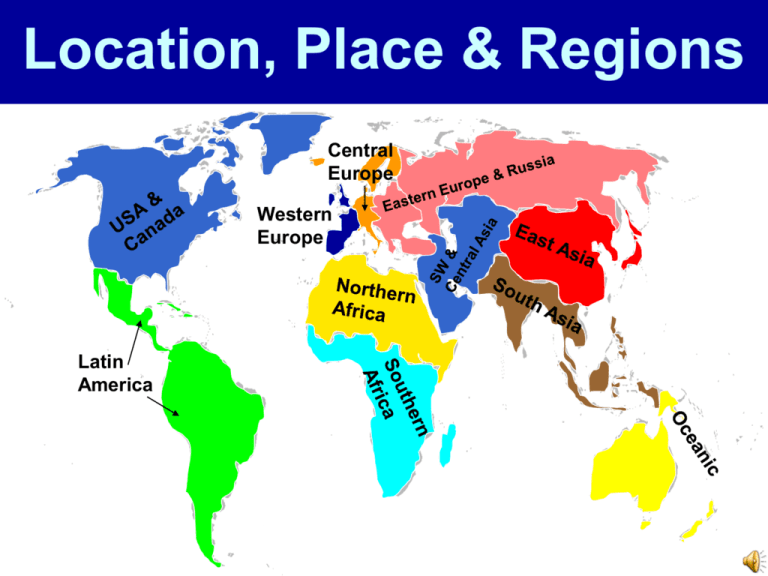
Location, Place & Regions Central Europe Western Europe Latin America • Geographers use many methods to study and teach about human activities on earth..…one method is to use “The 5 Themes of Geography” – Location – Place – Region – Movement – Human Environment Interaction Location • Geographers consider four ways to identify location…or the position that something occupies on earth: – Place – Site – Situation – (Relative location) – Mathematical location – (Absolute location) Place • What do you think when you imagine China? Japan? Russia? Saudi Arabia? • Place is unique collection of features that contribute to a locations distinctiveness. Place Names (Toponyms) • Nearly every place, both inhabited and uninhabited have names. • Named for a person – – – – George Washington – 1 state, 31 counties, dozens of cities – including capital V.I. Lenin – Leningrad Queen Victoria – Victoria Falls, Lake Victoria, Victoria BC James Monroe – Monrovia, Liberia • Associated with religion – St. Louis, St. Paul, San Diego Vatican City, Mecca, Jerusalem • Indicate the origin of the settlers – – – – N. America & Australia British Brazil Portuguese Latin America Spanish South Africa Dutch & British • Represent the physical environment – Virginia Beach, Salt Lake City, Interlaken, Volgograd, Amsterdam Place Names • Places can change names. • • • • New Amsterdam New York St. Petersburg Leningrad St. Petersburg Byzantium Constantinople Istanbul Bombay Mumbai • Longest community name in the world – Welsh town of – Llanfairpwllgwyngyllgogerychwyrndrobwllllantysiliogogogoch – 58 letter name that means “the Church of St. Mary’s in the grove of the white hazelnut tree near the rapid whirlpool and the Church of St. Tisilio near the red cave” SITE - Sight • Site – The physical (internal) character of a place. • Important Site characteristics – – – – – – – Climate Water Sources Topography Soil Vegetation Latitude Elevation • The combination of physical features gives each place a distinctive character. SITE • Site factors have always been essential in selecting locations for settlements. – Hilltop site – Athens, Jerusalem, Rome – River site – Paris, London, Pittsburgh – Harbor site – Hong Kong, Norfolk, Sydney – Island site –Singapore, Manhattan • Humans have the ability to modify the characteristics of a site. – New York City – twice as large today as in 1626 – Boston & Tokyo have also expanded Site: Lower Manhattan Island Fig. 1-6: Site of lower Manhattan Island, New York City. There have been many changes to the area over the last 200 years. Situation-(relative location) • Situation is the location of a place relative to other places. • The more interconnected a place is to other powerful places, the better its situation. • Situation is a valuable way to indicate location, for two reasons: • Finding an unfamiliar place » Directions: » Bayside HS is W of Independence • Understanding that place’s importance – Singapore – situated near the Strait of Malacca which is a the major passageway for ships traveling between the South China Sea and the Indian Ocean Mathematical Location Latitude --Lines of latitude measure distances north-south between the poles. --The equator is defined as 0 degrees --The North Pole is 90 degrees north --The South Pole is 90 degrees south --Lines of latitude are all parallel to each other, thus they are often referred to as parallels. They look like rungs on a ladder. Remember LA for ladder and latitude. Longitude --Lines of longitude, or meridians, run between the North and South Poles. --They measure distances east-west from the Prime Meridian. --The prime meridian is assigned the value of 0 degrees, and runs through Greenwich, England. Time Zones • 360° Longitude – 0-180 ° W & 0-180 ° E • Approx. every 15 degrees longitude is a different time zone • The Prime Meridian (0 ° longitude) is Greenwich Mean Time (GMT) or Universal Time (UT). Regions • The “Sense of Place” that humans possess usually apply to a large area rather than a specific point. • An area of Earth defined by one or more distinctive characteristics is a region. • A region can apply to any area larger than a point and smaller than the entire planet. • Regions are natural phenomena or human constructs that can be mapped and analyzed. • Geographers identify three types of Regions Three Basic types of Regions 1. Formal— (uniform/homogeneous) governmental boundaries (USA, Virginia, Brazil), physical regions (The Rockies, Great Lakes, Wheat belt), cultural (religion, language) Three Basic types of Regions 2. Functional— (nodal) defined by a function. -newspaper service -public schools -pizza delivery -river drainage basin -railroad system Three Basic types of Regions 3. Vernacular— (perceptual) loosely defined by people’s perception (The South, The Middle East) Which is “the South”?? Sunbelt Gulf Coast Southwest SOUTH Let’s take a quick look at Climate Regions World Climate Regions Low Latitudes World Climate Regions • Tropical wet: hot all year with high yearly precipitation—100 inches • Tropical wet & dry: hot all year with about 50 inches of precipitation • Arid: hot days, cold nights, with very low yearly precipitation—5 inches • Semiarid: hot summers, mild-to-cold winters, with low yearly precipitation • Highland: wide variety of temperatures and precipitations depending on the elevation and wind direction Mid Latitudes Mid Latitudes • Arid: hot days, cold nights, very low yearly precipitation—5 inches • Semiarid: hot summers, mild-to-cold winters, with low yearly precipitation • Mediterranean: hot summers, cool winters, with moderate precipitation—23 inches • Humid continental: warm summers, cold winters, with moderate precipitation—27 inches • Marine west coast: warm summers, cool winters, with high precipitation—45 inches • Highland: varies due to elevation and wind High Latitudes High Latitudes • Sub-arctic: cold winters, short warm summers, with low yearly precipitation • Tundra (sub-polar): cold summers, very cold winters with low yearly precipitation • Icecap: cold all year, with very low yearly precipitation Natural Vegetation Regions Vegetation Regions are classified into four general types: • Rain forest: tropical region with heavy concentration of broadleaf trees • Savanna: also tropical, but with grassy, treeless plains • Desert: only plants that can stand dry conditions such as cacti and sagebrush, survive • Steppe: grasslands in the middle latitudes • Middle latitude forests: trees that shed their leaves (deciduous trees) are mixed with tree with cones (coniferous trees) • Taiga: a cold-climate belt of coniferous forest • Tundra: colder than taiga, treeless, and barren Cultural Regions • Origin of culture is Latin “cultus” which means “to care for.” To care about – Ideas (language, religion) To take care of –Possessions (food, clothing, shelter) Central Europe Northe rn Africa Eas t As ia So uth As ia e Oc ern uth So ica Afr Latin America Ce & nt ra lA sia Western Europe SW A & da S U ana C a ussi e &R p o r u er n E East an ic Cultural Regions • Culture, although a man-made phenomena, occurs in coordination with the natural world as humans interact with their environment. – We’ll study more about cultural Regions throughout the year and specifically in Unit #3. Human-Environment Interactions • The geographic study of humanenvironment relationships is known as cultural ecology. • This is often referred to as HEI (Remember human environment interaction from the Five themes of Geography???) Does the environment impact human actions? Environmental Determinists Think So! • German Geographers Alexander von Humboldt (1769-1859) & Carl Ritter (1779-1859) promoters of environmental determinism They theorized that geography was the study of how the physical environment caused human activities. Much like Social Darwinism ….somewhat racist ….Eurocentric …not as applicable today due to technology! Do human actions impact the environment? Possiblists Think…“Yes”! • Carl Sauer’s theory that states …… ……….the physical environment may set limits on human actions, but people have the ability to adjust to the physical environment. Human-Environmental Interactions • How do humans and the environment affect each other? • Three key concepts: 1. Humans adapt to the environment. 2. Humans modify the environment. 3. Humans depend on the environment. Environmental Impacts on Humans • Settlement Patterns • (why don’t more people live in the Sahara Desert, or in Antarctica?) • Humans cannot live in the five toos: • Too hot, too cold, too wet, too dry, too steep Environmental Impacts on Humans • Housing Materials (bricks, bamboo, lumber, ice, dirt & mud) Environmental Impacts on Humans • Agricultural Activity (rice, wheat, potatoes, corn, coffee) Environmental Impacts on Humans • Types of Recreation (camping, sunbathing, fishing, skiing) Environmental Impacts on Humans • Transportation Patterns (car, boat, train, airplane) Now let’s flip-flop….. Human Impacts on the Environment • • • • Canals (Suez, Panama) Dams (Aswan, Hoover) Reservoirs (Nasser, Mead) Irrigation (Aral Sea) Human Impacts on the Environment • Agricultural terracing (China, SE Asia) • Polders (Netherlands) • Deforestation (Brazil, D.R.C., Malaysia) • Desertification (Africa, Asia) GREEN WALL OF CHINA Human Impacts on the Environment • Acid Rain (Germany, China, Eastern U.S.A.) • Pollution (Mexico City, Chernobyl, oil spills) Chernobyl Environmental Determinism or Possiblism? Either way… the environment and human actions shape the regions that exist on earth!
